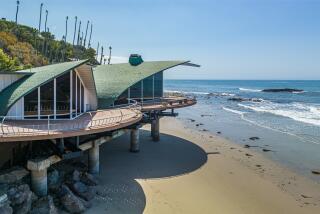LeRoy Cluff Major; Tract Housing King
- Share via
LeRoy Cluff “L.C.” Major, once dubbed by Time magazine as America’s “tractioneer” for his creation of more than a million tract homes across the United States, has died. He was 85.
Major, whose L.C. Major & Associates designed convalescent homes and senior citizen housing as well as family residences, died Sunday in his home in Yorba Linda after a long illness.
“Nobody has designed houses for more people than L.C. Major,” a 1992 article in Professional Builder and Remodeler magazine stated. “He is the grand old man of for-sale housing in the United States. He and his associates have designed more houses for more builders than any other single company--and thus designed homes for more people than anyone in the world.”
Major is credited with training and encouraging such leading building marketers as Sandy Goodkin, considered the first to coordinate colors and landscape driveways in home merchandising, and such contemporary architects as Berry Berkus, Ted Hales and Frank Gonzales. Yet Major himself was not an architect--merely the son of one--and had little formal training.
After a single year of drafting classes in high school, Major began his career in 1933 as a real estate appraiser and worked successively for the Federal Housing Administration, the Veterans Administration and a bank.
He gravitated to drafting and designing during the housing boom that followed World War II. From 1945, when he established his L.C. Major & Associates, based over the years in Downey, Santa Ana and more recently Orange, the innovative non-architect set out to do practically everything builders needed except actually pour concrete and nail frames together.
It was a novel idea and one that worked. Starting with the two-bedroom, one-bath bungalows so prevalent in the late 1940s, Major offered builders and developers master planning, market research, cost analysis, home design, architectural renderings, color coordination, model home furnishing, landscaping, merchandising, promotion and financial counsel.
“All of these factors must be considered and decided upon before a foundation is laid,” Major said in 1961, “if the builder is to produce a salable house which is profitable to build and meets the total housing needs of the potential homeowner.”
Over the decades, Major adapted easily to changing tastes and prospering home buyers. Soon he was designing luxury custom homes, condominium complexes and retirement housing. He also branched out into institutional buildings such as convalescent homes, and competed successfully for contracts to build low-cost, energy-efficient housing.
Major served nationwide home builders and also sold plans through trade magazines to individual builders. His work earned numerous awards over the years, including several Gold Nugget awards from the Pacific Coast Builders Conference.
An elder in the Mormon church, Major was active in builders’ organizations and in his community, coaching youth sports in particular.
He is survived by his wife of 59 years, Loraine; two sons, Ken and Brent; a sister and a brother, six grandchildren and five grandchildren.
More to Read
Sign up for Essential California
The most important California stories and recommendations in your inbox every morning.
You may occasionally receive promotional content from the Los Angeles Times.






